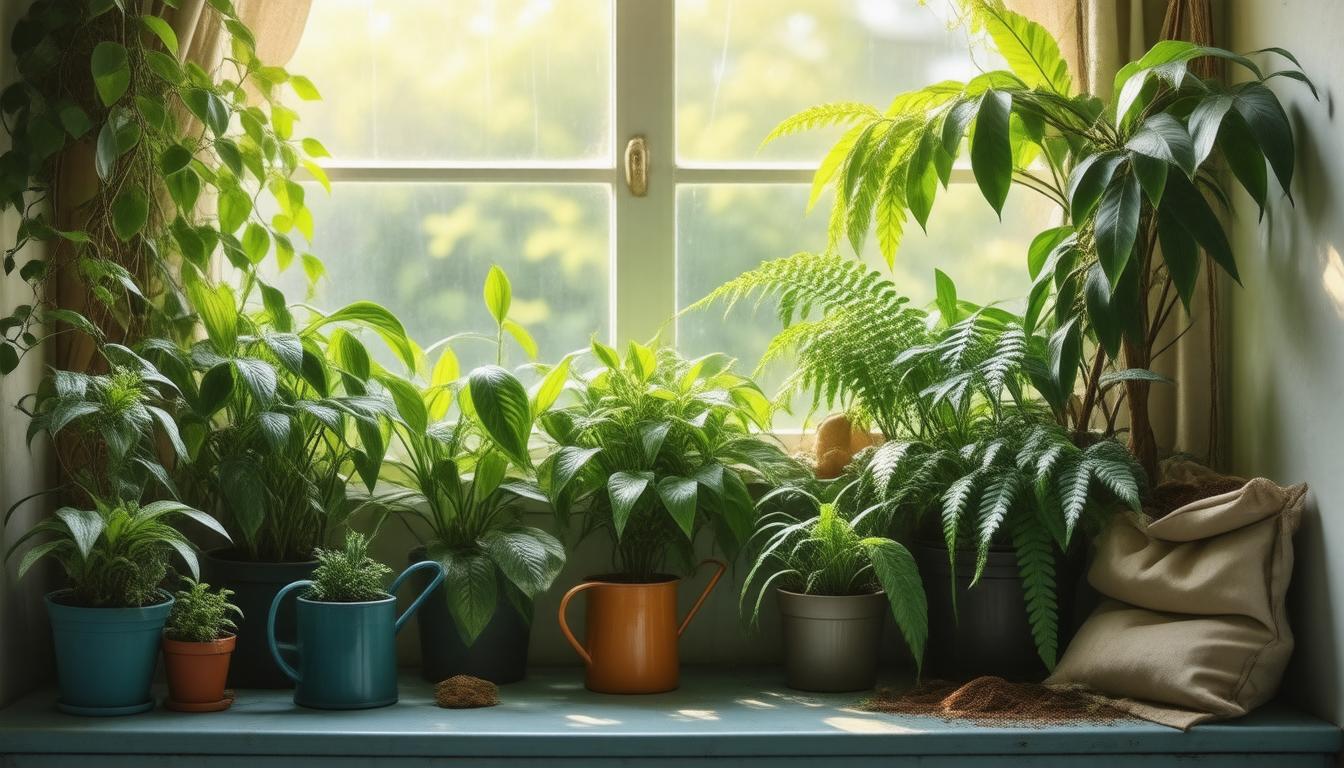Indoor Plant Care Simplified: Expert Tips for Beginners and Enthusiasts
Bringing greenery indoors can transform your living space, improve air quality, and boost your mood. However, managing indoor plants can be daunting for both newcomers and seasoned plant enthusiasts. In this guide, we’ll explore how to simplify your indoor plant care routine by providing expert tips designed for everyone—from the casual plant owner to the dedicated enthusiast. Whether you want to spruce up your apartment or cultivate an indoor garden, our comprehensive advice will help you flourish in your indoor gardening journey.
Key Takeaways
- Start with the basics of light, water, and soil to create a solid foundation for your indoor plants.
- Select indoor plants that thrive in your specific space conditions, such as light and humidity.
- Equip yourself with essential tools like watering cans, pruning shears, and moisture meters to make plant care easier.
- Learn about common challenges such as pests and overwatering, and have solutions ready for quick problem-solving.
- Establish a seasonal care routine that adapts to changing plant needs to ensure healthy growth year-round.
Understanding the Basics of Indoor Plant Care
Indoor Plant Care Simplified: Expert Tips for Beginners and Enthusiasts is essential for anyone looking to create a thriving green space in their home. To ensure your plants flourish, start by understanding their specific light, water, and soil needs. Most indoor plants prefer bright, indirect light, so placing them near windows can be beneficial, but avoid direct sunlight that can scorch their leaves. Watering is critical; generally, plants prefer to dry out a bit between waterings, so check the top inch of soil before adding more water. Additionally, opting for a well-draining potting mix can help prevent root rot. Regularly monitoring your plants for pests and diseases will also keep them healthy and vibrant. By following these fundamental indoor plant care tips, both novices and plant enthusiasts can cultivate a beautiful, thriving indoor garden.
Choosing the Right Indoor Plants for Your Space
Choosing the right indoor plants for your space can transform your home into a vibrant oasis while improving air quality and enhancing your mood. However, it’s essential to match your plant selection to your lifestyle and environment. For those new to this green endeavor, the concept of ‘Indoor Plant Care Simplified: Expert Tips for Beginners and Enthusiasts’ becomes vital. Start by assessing the light levels in your space—some plants thrive in bright, direct sunlight, while others prefer low-light conditions. Consider your schedule as well; low-maintenance plants like pothos or snake plants are perfect for busy individuals, while more delicate species like orchids require a bit more attention. Additionally, ensure you select pots with proper drainage to prevent overwatering, a common mistake among beginners. With the right choice of indoor plants and a few simple caring strategies, you can enjoy a flourishing indoor garden that enriches your life.
‘The best time to plant a tree was twenty years ago. The second best time is now.’ – Chinese Proverb
Essential Tools and Supplies for Successful Indoor Gardening
For anyone looking to embark on the journey of indoor gardening, having the right tools and supplies is crucial for thriving plants and a rewarding experience. Indoor Plant Care Simplified: Expert Tips for Beginners and Enthusiasts emphasizes that starting with essential items can make all the difference. Begin with high-quality pots that offer good drainage, as stagnant water can lead to root rot. Invest in soil that is specifically formulated for indoor plants, as it often provides the right balance of nutrients and aeration to keep your green friends happy. A moisture meter is an excellent tool for beginners, helping you to monitor soil moisture levels and avoid overwatering—a common mistake in indoor plant care. Don’t forget to grab a pair of pruning shears to keep your plants healthy and well-shaped, along with fertilizer designed for indoor varieties, to promote growth throughout the seasons. Lastly, consider obtaining grow lights if natural sunlight is limited in your space. By equipping yourself with these essential tools and supplies, you’ll set a solid foundation for indoor plant care, simplifying the process while enhancing your indoor garden.
Common Indoor Plant Care Challenges and Solutions
Indoor plant care can sometimes feel overwhelming, especially for beginners and even seasoned enthusiasts. One common challenge is choosing the right plant for your environment. Not all plants thrive under the same conditions, so understanding your space’s light, temperature, and humidity levels is crucial. To simplify indoor plant care, start with easy-to-maintain varieties such as pothos or snake plants, which are forgiving and adaptable. Another frequent issue is watering; overwatering is a common mistake that can lead to root rot, while underwatering can cause plants to wilt. A practical solution is to check the top inch of soil; if it feels dry, it’s time to water. Furthermore, indoor plants can suffer from pest infestations, so regular inspections and natural pest control methods can keep your greens healthy. Fertilizing at the right times can also enhance growth and vitality, typically every month during the growing season. By leveraging these expert tips, indoor plant care can be simplified, allowing you to enjoy the beauty and benefits of greenery in your home.
Seasonal Care Tips for Indoor Plants
Caring for indoor plants can seem daunting, but with the right knowledge and practices, indoor plant care can be simplified for both beginners and enthusiasts. Seasonal changes significantly affect your plants’ needs, so it’s essential to adapt your care routine throughout the year. During spring, as the days grow longer and warmer, most indoor plants will enter a growing phase. Increase watering and consider repotting if your plants have outgrown their pots. Summer brings heat; ensure your plants receive adequate hydration but be wary of direct afternoon sun, which can scorch leaves. As fall approaches, prepare your indoor plants for dormancy by reducing watering and allowing for natural light adjustments. In winter, many plants require minimal care. Lower temperatures and decreased daylight call for reduced watering and careful monitoring for pests, particularly in dry indoor air. By following these seasonal care tips for indoor plants, you can enhance your green thumb and enjoy the beauty of thriving foliage in your home, all while keeping the process of indoor plant care simplified.
Creating an Indoor Plant Care Routine for Longevity
Creating an indoor plant care routine is essential for ensuring the longevity and vibrancy of your beloved greenery. With indoor plant care simplified, anyone from beginners to enthusiasts can follow a few expert tips to establish a nurturing environment. Start by understanding the specific needs of each plant species you own, focusing on light requirements, watering schedules, and humidity preferences. Regularly inspect your plants for any signs of pests or diseases, making prompt adjustments to your care routine as needed. Incorporating quality potting soil and selecting the right-sized containers can also contribute to healthier growth. By committing to a consistent schedule that includes routine watering, fertilizing, and repotting when necessary, you’ll not only enhance the beauty of your indoor plants but also enjoy the therapeutic benefits they offer. Remember, a well-structured indoor plant care routine doesn’t just sustain life; it fosters an enriching lifestyle that can brighten up any home.
Frequently Asked Questions
What are some beginner-friendly indoor plants?
Some beginner-friendly indoor plants include pothos, snake plants, peace lilies, and spider plants. These plants are resilient, require minimal care, and can thrive in various conditions.
How often should I water my indoor plants?
The frequency of watering depends on the type of plant and its environment. Typically, it’s best to check the soil moisture; if the top inch of soil feels dry, it’s time to water. For most indoor plants, watering every 1-2 weeks suffices.
What tools do I need for indoor plant care?
Essential tools include pots with drainage holes, a watering can, pruning shears, a spray bottle for humidity, a soil moisture meter, and fertilizer suitable for your plant type.
How can I prevent common indoor plant problems?
To prevent issues, ensure proper watering practices, avoid over-fertilizing, and provide adequate light conditions. Regularly check for pests and signs of disease, and promptly address any problems.
What seasonal care tips should I follow for indoor plants?
In the spring and summer, focus on watering and fertilization, as plants actively grow. In fall and winter, reduce watering and consider placing plants near light sources as natural light decreases.




